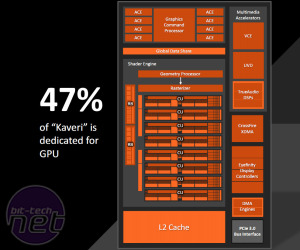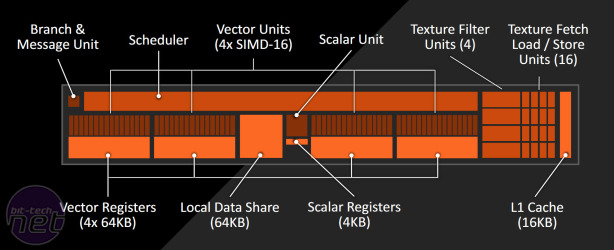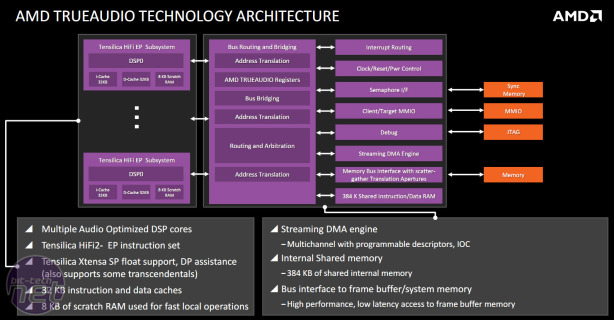
GCN Graphics
Kaveri is the first APU series to feature AMD's GCN architecture, the same as that in the R9 and R7 cards that form its current GPU lineup. AMD typically trumps Intel when it comes to onboard graphics performance, and the 47 percent of die space allocated to the graphics hardware alone suggests that's a trend it would like to continue.At the front end is a single graphics command engine alongside eight Asynchronous Compute Engines (ACE), a design shared by the R9 290X and R9 290. The ACEs work in parallel with the main engine so that graphics and compute workloads can be processed at the same time.
As ever, the main grunt of the GCN GPU comes from its Compute Units, of which Kaveri has a maximum of eight. This gives it a maximum total of 512 stream processors, the same number as both the R7 250 and HD 7750 (though these cards have higher clock speeds and GDDR5 memory). The flagship A10-7850K is the only announced part with this many cores; the A10-7700K and A8-7600 both have six Compute Units for a total of 384 cores, the same as the A10 Richland parts. Clock speeds have again gone down, with all three parts clocking in at 720MHz compared to 844Mhz before. AMD is thus relying mostly on the new GCN architecture to boost performance over the older chips.
Rounding out the pipeline is a single geometry processor (which includes a tesselator) and a rasterizer. There are also two of AMD's Render Back End units, each of which is home to four ROPs.
Of course, compared to most discrete graphics cards, Kaveri's GPU is very underpowered. Nevertheless, AMD is confident that Kaveri offers a good value gaming solution, and boasts that it's capable of achieving 30fps in modern games at 1,920 x 1,080 (although obviously not with all the details cranked up). Naturally, we'll be putting this to the test, as it's certainly something of a baseline for gaming experiences in a world dominated by 1080p panels. As for video output, Kaveri should comfortably be able to deal with 4K 60Hz displays, assuming you've got a motherboard with a DisplayPort 1.2 output.
As well as being enhanced for DirectX 11.2 support, the GCN hardware inside Kaveri also means that it supports AMD's Mantle API, which is designed to reduce the overhead of Direct3D (especially that on CPU draw calls) and thus boost performance. We're getting rather bored of AMD's claims about how much performance can be improved using Mantle – they're largely meaningless until the Battlefield 4 patch is released, so we'll leave it at that for now.
Like the R7 260X and R9 290 and 290X cards, Kaveri features TrueAudio. We've detailed this before here, but it's essentially a dedicated audio processor that games and software developers can offload sound processing to. It thus frees up CPU resources while also giving developers the power to sample and process many more sounds and effects. The first game set to take advantage of it is Thief, due out in February.
Kaveri also sees the return of the Video Coding Engine (VCE) and Unified Video Decoder (UVD), which are dedicated hardware blocks that enable GPU accelerated encoding and decoding. They have both been tweaked so as to support additional formats and improve error resiliency.
As we said, much of Kaveri is about improving performance per watt (per dollar) and thus efficiency. Crucial to this is reducing overhead and assigning the right workloads to the right parts of a chip, and both Mantle and TrueAudio (as well as the encode/decode accelerators) are clear extensions of this principle.
The other hardware blocks within the GPU are the DMA and CrossFire XDMA engines as well as the Eyefinity Display controllers. The latest information on pairing a discrete GPU with Kaveri via CrossFire is that it must be an R7 series card that uses DDR3, although the drivers for this aren't fully ready yet. Naturally, you can also use any Nvidia or AMD card as a single discrete GPU too.

MSI MPG Velox 100R Chassis Review
October 14 2021 | 15:04












Want to comment? Please log in.